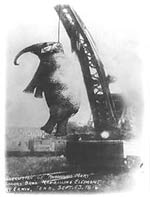|
June
4, 1983 Saturday (1812.2mtg) From
Gonzo!s Appalachian Trail journal
Taken
from an article by JOAN VANNORSDALL SCHROEDER in the Blue
Ridge Country Magazine.
No one denies that Mary killed Eldridge in Kingsport, Tenn. on September
12, 1916. The details of why and how it happened, gathered from
oral-history tapes from the Archives of Appalachia at East Tennessee
State University, vary so wildly that they should be read with skepticism,
and no small dose of chagrin.
Version I. After the Kingsport performance, Red Eldridge was assigned
to ride Mary to a pond, where she could drink and splash with the
other elephants. According to W.H. Coleman, who at the tender age
of 19 witnessed the "murder":
There was a big ditch at that time, run up through Center Street,
...And they'd sent these boys to ride the elephants... There was,
oh, I don't know now, seven or eight elephants... and they went
down to water them and on the way back each boy had a little stick-like,
that was a spear or a hook in the end of it... And this big old
elephant reach over to get her a watermelon rind, about half a watermelon
somebody eat and just laid it down there; 'n he did, the boy give
him a jerk. He pulled him away from 'em, and he just blowed real
big, and when he did, he took him right around the waist... and
throwed him against the side of the drink stand and he just knocked
the whole side out of it. I guess it killed him, but when he hit
the ground the elephant just walked over and set his foot on his
head... and blood and brains and stuff just squirted all over the
street.
Version II. As reported in the September 13, 1916 issue of the Johnson
City Staff, Mary "collided its trunk vice-like [sic] about
[Eldridge's] body, lifted him 10 feet in the air, then dashed him
with fury to the ground... and with the full force of her biestly
[sic] fury is said to have sunk her giant tusks entirely through
his body. The animal then trampled the dying form of Eldridge as
if seeking a murderous triumph, then with a sudden... swing of her
massive foot hurled his body into the crowd."
Version III. Maybe Mary was simply bored, as a staff writer for
the Johnson City Press-Chronicle suggested in 1936. "The elephant's
keeper, while in the act of feeding her, walked unsuspectingly between
her and the tent wall. For no reason that could be ascertained,
Mary became angry and, with a vicious swish of her trunk, landed
a fatal blow on his head."
Version IV. Or did Mary kill Red Eldridge because she was in pain?
Erwin legend has it that Mary had two abscessed teeth, which caused
her such agony that she went berserk when Eldridge tapped her with
his elephant stick. The infections were, of course, discovered only
after Mary was killed.
Regardless of the details, the end was the same -- a man dead. Justice
to be served. And besides, Charlie Sparks was no fool: no town in
Tennessee would invite his circus to perform with a certifiably
rogue elephant. Johnson City, where performances were scheduled
for September 26, had already passed a privilege-tax ordinance restricting
carnivals' oper- ations within city limits, in order to protect
its citizens from wholesale fleecing; it was common knowledge that
Johnson City officials were looking for an excuse to ban all traveling
shows. As valuable as Mary was, she had to go.
The problem was, how?
Guns, of course, were the first course of action. Just after Eldridge's
death, blacksmith Hench Cox fired his 32-20 five times at Mary;
the story goes that the bullets hardly phased her. "Kill the
elephant. Let's kill him," the crowd began chanting. Later,
Sheriff Gallahan "knocked chips out of her hide a little"
with his .45, according to witness Bud Jones. But the circus manager
stated, "There ain't gun enough in this country that he could
be killed"; another approach would have to be attempted.
Someone suggested electrocution: "They tried to electrocute
her in Kingsport -- they put 44,000 volts to her and she just danced
a little bit," railroader Mont Lilly claimed. Others report
that electrocution was never an option, because there wasn't enough
power running in the railroad yards to affect Mary. (Since most
American railroads continued to use steam locomotives until the
1930s, it's curious that railroad electrocution was even a possibility.)
Other reports suggest a third execution method: hooking Mary to
two opposing engines and dismembering her, or crushing her between
two facing engines. Both were dismissed as too cruel.
And so it was decided, instead, that Murderous Mary would be hung
by the neck from a derrick car the next day.
The Execution
Mary didn't perform for the matinee performance the day she died.
She was chained outside the circus tent, and folks say she spent
the entire performance time swaying nervously. The crowd's dissatisfaction
with her absence was mollified by the announcement that Mary would
be hung in the Clinchfield Railyards later in the afternoon -- with
no additional charge for admission.
More than 2,500 people gathered to watch Mary swing near the turn-table
and powerhouse on that drizzly afternoon; perhaps the number of
eyewitnesses, as well as the unforgettable, sad spectacle of the
event, explains the consensus on this part of the story.
Gonzo!
Appalachian Trail Journals ©1983
|

